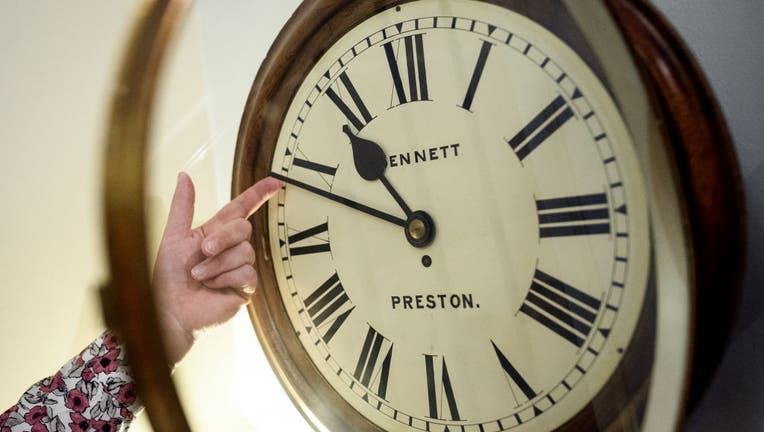Here's when daylight saving time ends in Minnesota

LONDON, ENGLAND - APRIL 01: Duncan Clements of Pendulum of Mayfair antique clock specialists carries out the summertime adjustment of the clocks, regulators and timepieces in the display rooms on April 01, 2019 in London, England. The European Parlia (Getty Images)
(FOX 9) - With a bill to make daylight saving time permanent stalled in Congress, the practice of changing our clocks every year, twice a year, to "spring forward" or "fall back" is unlikely to end anytime soon.
Daylight saving time (DST) will end at 2 a.m. on Sunday, Nov. 6, meaning Minnesota residents will have to set their clocks back one hour, but it could be for the last time.
Push for change, now stalled.
As many Minnesota residents are well aware, it can be challenging to change long-established systems, even unpopular ones like daylight saving.
There was a change in the air in March when the Senate passed the Sunshine Protection Act. The bill was championed by the senior senator from the Sunshine State, Marco Rubio.
In a position paper, Rubio pointed to academic studies indicating that making daylight saving permanent, or in effect, ending the practice of "falling back:" in November, would have far-reaching benefits, including:
- Reducing car accidents and seasonal depression (because of more sun)
- Improving physical fitness due to increased pedestrian and cyclist activity
Rubio also had doctors on his side: The American Academy of Sleep Medicine (AASM) recommends ending daylight saving time, and the survey they conducted in 2020 indicated that 63% of adults in the United States agreed.
In a time of intense political division, the Sunshine Protection Act was a rare example of an issue that brought Republicans and Democrats together: the bill passed by unanimous voice vote on March 15.

No more clock changes? Sunshine Act closer to becoming reality
Congress is one step closer to making to making daylight savings time permanent. In Minnesota, that would mean darker winter mornings.
However, the House has yet to take up the measure. The bill would need to go through the House Energy and Commerce Committee, and in July, that committee's chair, Rep. Frank Pallone Jr. (D-N.J.), told The Hill in July that he didn't see making daylight saving time permanent as a priority.
He did offer a glimmer of hope, however, suggesting that there was a chance the committee could consider the idea sometime in the fall.
If the Sunshine Protection Act passes and the president signs, the bill would move time forward by one hour to what is currently considered the standard time by the federal government, beginning in November 2023.
The current DST period in the United States begins on the second Sunday of March when clocks are moved forward one hour, giving people extra time to sleep. The clocks are turned back an hour to standard time on the first Sunday in November as the DTS cycle ends.
Bonus content
In the last five years, 19 states have enacted legislation or passed resolutions for year-round DST - Minnesota being one of them.
Two states - Arizona and Hawaii - and several U.S. territories observe permanent standard time.
At one point in 1965, Minneapolis and St. Paul were in different "time zones" or an hour apart because of a disagreement over daylight saving time. Read the fascinating history in Minn Post.

